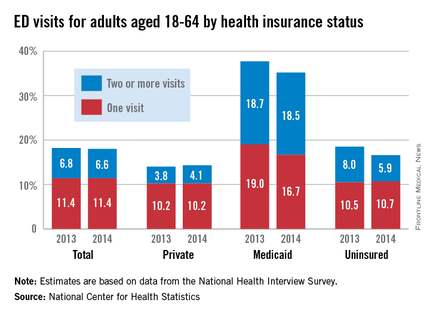Adults aged 18-64 with Medicaid coverage were almost twice as likely as all adults to visit the emergency department in 2014, according to the National Center for Health Statistics (NCHS).
In 2014, an estimated 35.2% of Medicaid recipients aged 18-64 years visited the emergency department at least once, with more than half of those (18.5%) being people who made two or more visits for the year. Among all adults aged 18-64, 18.0% made at least one ED visit, while 6.6% of all adults made two or more. In 2014, 14.3% of adults 18-64 with private insurance made one or more ED visits, as did 16.6% of those who were uninsured, the NCHS reported.
Compared with 2013, adults with ED visits were down slightly for all adults (18.2% to 18.0%), up slightly for those with private insurance (14.0% to 14.3%), and down for those with Medicaid (37.7% to 35.2%) and the uninsured (18.5% to 16.6%), the report showed.
There was a significant decrease for uninsured adults with two or more visits from 8.0% in 2013 to 5.9% in 2014 (P less than .05), and the drop among Medicaid recipients with one ED visit from 19% in 2013 to 16.7% in 2014 was significant at P less than .1, the NCHS noted.
The highest rates of ED use among adults have consistently been associated “with public health coverage such as Medicaid, relative to adults who were uninsured or had private health insurance. This higher rate of use may be related to more serious medical needs in the Medicaid population,” the NCHS investigators said.
Younger individuals (ages 18-29) were more likely to visit the ED, with 20.2% having at least one visit in 2014, compared with 16.8% of those aged 30-44 years and 17.5% of those aged 45-64. There also were differences by race and ethnicity, as 26.5% of non-Hispanic blacks made one or more ED visits in 2014, compared with 17.5% of non-Hispanic whites and 15.7% of Hispanics, according to the report, which was based on data from the National Health Interview Survey (n = 26,825 for 2013 and 28,053 for 2014).


